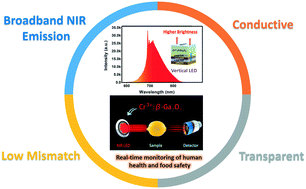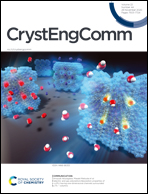Broadband near-infrared Cr3+:β-Ga2O3 fluorescent single crystal grown by the EFG method
Abstract
Broadband near-infrared (NIR) light-emitting diodes (LEDs) have important applications in non-destructive detection across agriculture, food, chemical and medical fields. LEDs coated with IR phosphors are widely used but have some shortcomings such as low efficiency, low brightness, short service life, and so on. Here, we propose a new strategy to solve the aforementioned problems by using the Cr3+:β-Ga2O3 single crystal as a transparent and conductive substrate with NIR fluorescent for the first time. The band structure and optical properties of the Cr3+:β-Ga2O3 crystal were calculated through density functional theory, and it was successfully grown by the edge-defined film-fed growth method. The crystal had a broad band absorption peak around 423 nm, which was located at the emitting band of the GaN LED. Broadband NIR emission from 600 nm to 850 nm with a peak maximum at 690 nm was found under the blue light excitation. Furthermore, the electrical properties of Cr3+:β-Ga2O3 were also studied by the Hall test. The spectral and electrical analyses indicate that Cr3+:β-Ga2O3 is promising in broadband NIR applications as a fluorescent substrate for vertical large current GaN LEDs. Combined with the advantages of low mismatch, transparency, conductivity and broadband NIR fluorescence, Cr3+:β-Ga2O3 provides a new strategy for high-brightness near-infrared broadband light sources.



 Please wait while we load your content...
Please wait while we load your content...